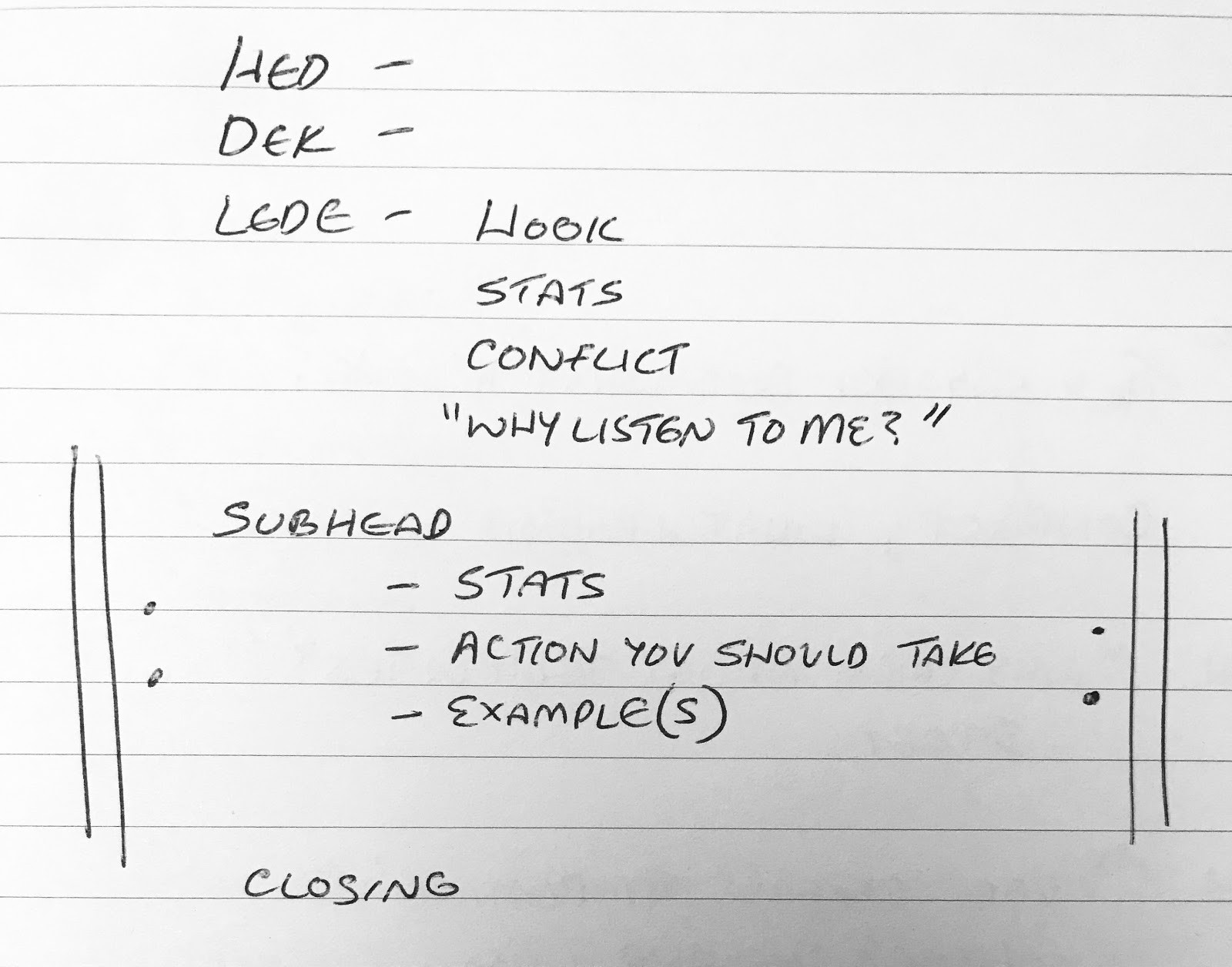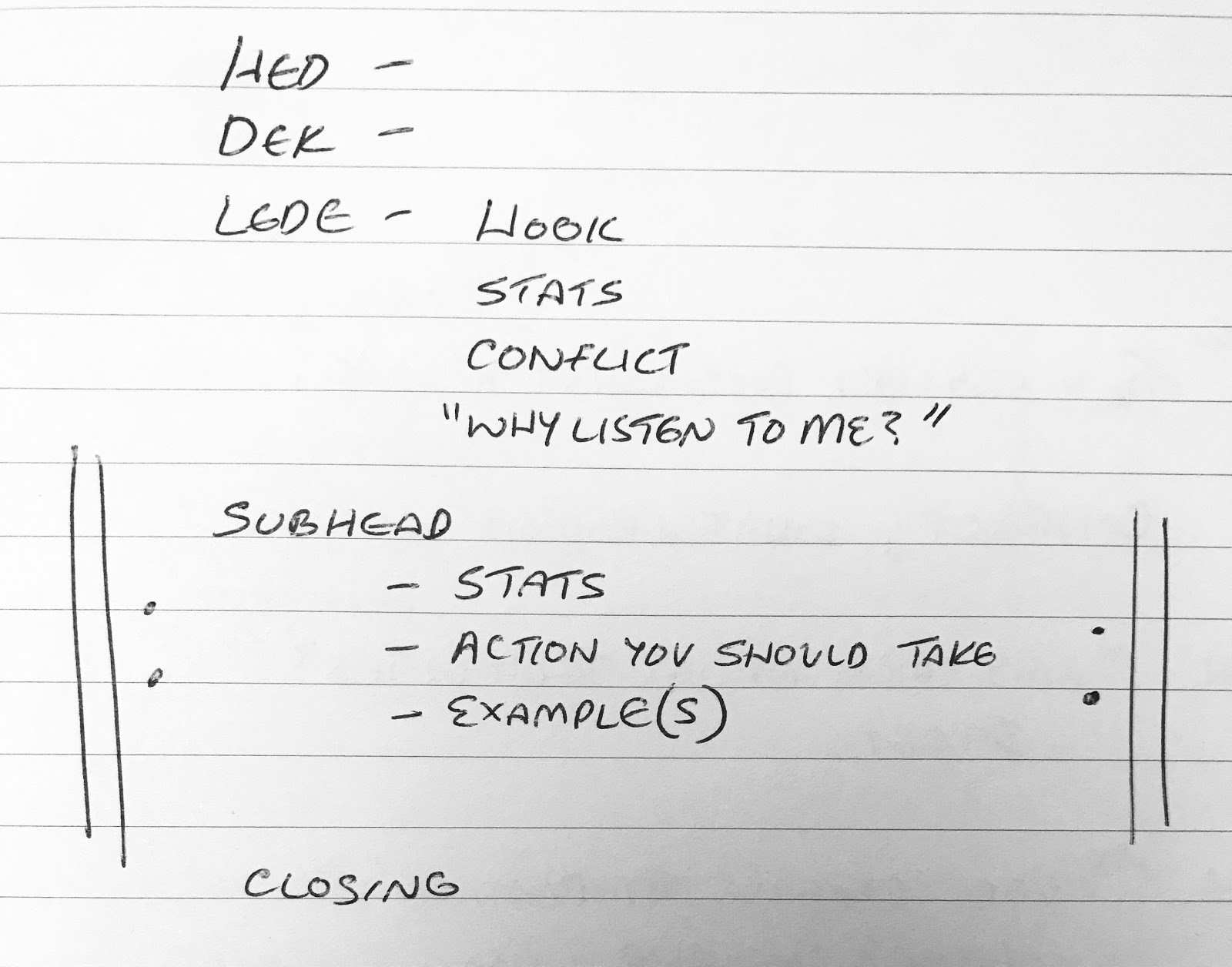HOW TO CREATE AND USE A TEMPLATE TO WRITE ARTICLES

“Write every day,” they said. You won’t need to go far to discover this advice plastered across the walls of the internet. But what if you’re juggling lots of responsibilities and daily writing is a big ask right now? Or worse, what if you do make the time to write frequently, yet find yourself still getting stuck? That’s where an article template comes in handy.
When I had my full-time job, I found frequent writing to be a challenge. I did my best to “rise and grind” and pump out articles before the workday began, but as the weekdays progressed I would often miss a day (or two or five) and struggle to regain my rhythm.
I also sometimes resented this approach when most of my hour before sunrise was spent staring at a blank page and I had nothing to show for my time — time I could have spent cuddling, exercising, or, best of all, sleeping.
During this period of intermittent writing, something that helped me make measurable progress was to create different article templates I could follow. Templates allowed me to more easily shape my ideas and provided a container that gave my first drafts direction and purpose.
I had found different article scripts on the internet and adopted them with marginal success. My best article templates, however, were ones that I had reverse-engineered myself from authors whose work I enjoyed. Similar to the plot of the 2010 film Inception, when the article template was my idea and my own creation, it was far more likely to stick and become a regularly-referenced tool in my writing toolbox.
Why an article template makes a first draft easier
At my former PR agency job, I was responsible for producing new pitch scripts each month for our group program clients to use when pitching television, contributed articles, podcasts, magazines, and other traditional outlets. The problem with these scripts, however, was that media pitches usually need to be very customized and unique to the target outlet. My scripts were riddled with fill-in-the-blank sections like “INSERT TOPIC HERE” and “REASON WHY THIS MATTERS NOW”, and still required substantial momentum and creativity from the consumer rather than a plug-and-play solution.
What I found added way more value was to share with these clients some of the successful pitches our professional publicists had created in the previous month. These pitches helped clients ‘mimic’ the structure of a winning pitch and apply it to their own area of expertise, and since the news cycle moves quickly, the pitch topics were antiquated and there was no longer a risk of cannibalizing publicist placements.
Our group program client results dramatically improved because it’s easier to mimic the format of an already-existing piece of content than try to reinvent the wheel. I personally had been doing something like this myself for years; when I found a great article or sales page that I liked, I would bookmark it and refer back to its format and pacing whenever I needed structural guidance around my own articles or sales copy.
Without realizing it, these winning pitches and bookmarked articles had become my go-to templates for better, quicker writing. I now like to call this process reverse templating; rather than try to make up a template or script from scratch, take sections of past online writing that you enjoy, analyze them, and use that analysis to create an arsenal of writing tools for yourself.
Create article templates you like through “reverse templating”
“Through others we become ourselves.”― Lev S. Vygotsky
When I began getting published in Entrepreneur, my first piece that got accepted followed a template that I had constructed for myself. I had pored through some of my previous favorite articles on their site, along with similar sites like Fast Company and Forbes, and whittled their structures down to what I felt was a common skeleton. This template is still my most frequently-used article template and looks like this.

Those symbols bracketing the subhead section are ‘repeat bars’; I went to music school, so sometimes I use musical symbols for shorthand. When I kept this chicken scratch template by my side, I began making it from blank page to first draft (Or flaming-wreckage first draft to comprehensible second draft) in far less time. This allowed me to produce more articles and improve my quality of writing overall.
With each new article template, map your logic
I prefer the word “template” to the word “script” because, with every article, you’ll eventually want to map out either the logic of your argument or the direction you want to take the reader.
For example, this article you’re reading right now follows a version of the template shown above; the main difference is that the subheads build on one another and flow in a sequential order.

The template acts as my container, and within that structure I flesh out the logic of my article. I ask myself what bits of information a reader will need, and in what order, to walk away fully equipped to take action immediately. This process cements my argument in my mind and gives my draft a North star as I revise and edit.

Write your first (or second) draft
There are times when the intention and purpose of my article are obvious, especially when the subject matter is drawn from my consulting background or commonly-asked client questions. But other times, when I’m not totally clear what my argument and the logic of that argument are, I end up free-writing a big ol’ mess just to get out of my head. Templates can work in both of these scenarios.
If you leverage a handcrafted template prior to your first draft, you’re likely to have much more direction and flow in your writing and be able to cut down on heavy reworks in future drafts.
And if you’re staring at an unintelligible pile of words, templates and the subsequent logic mapping described above will help you identify pearls of wisdom hidden in your first draft, extract them, and revise your idea into a clear and engaging opinion.
You can begin this process today with just one template, and if it helps, use the ones mentioned above to get yourself moving. As you explore what works best for your unique voice and writing style, a diverse selection of templates can be a valuable resource to help you get unstuck, take action on more ideas, and finish more of the articles you start.

